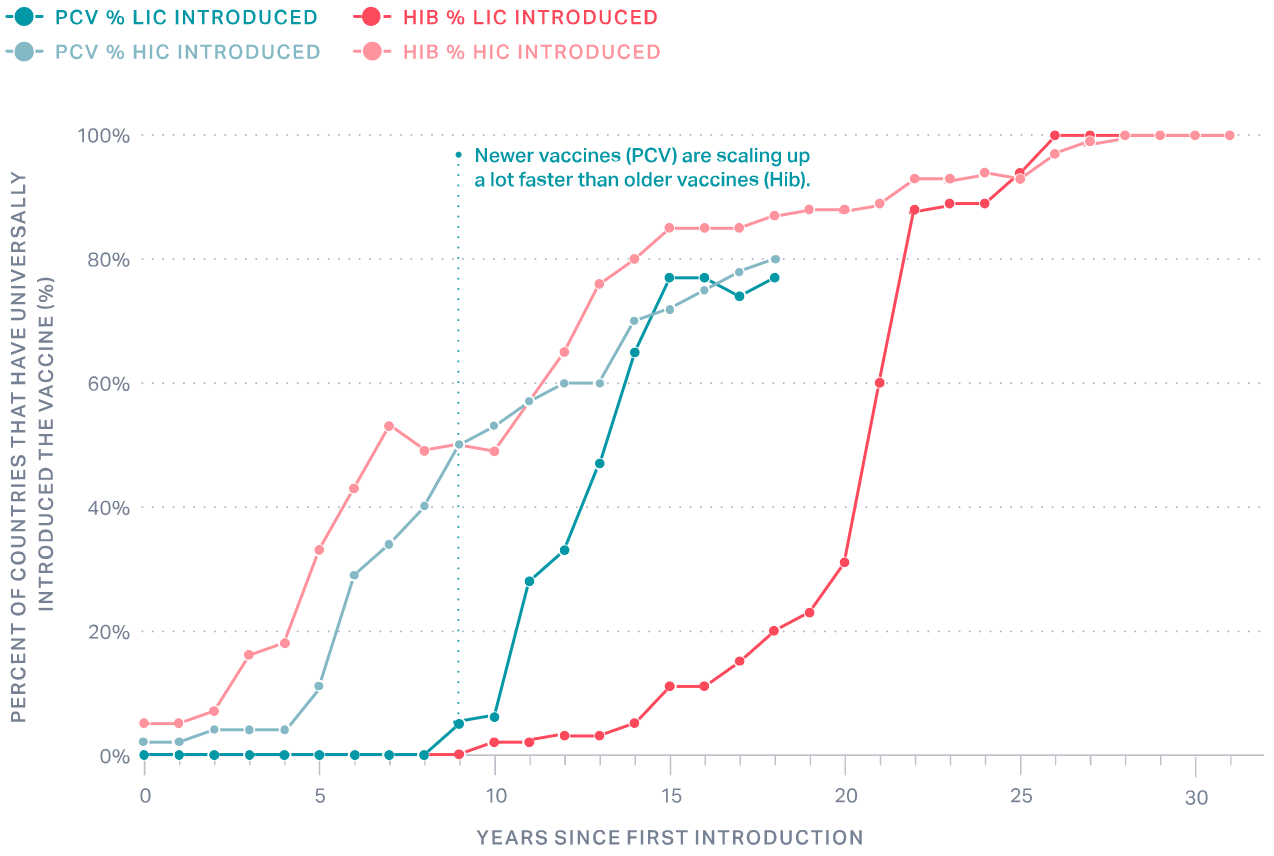DTP coverage
Immunization is one of the most successful public health programs the world has ever seen: it reaches more children than any other intervention. And more children are being vaccinated each year than ever before. In 2018, 116 million infants received 3 doses of DTP, and 86% of children worldwide now receive the recommended three doses of DTP vaccine before their first birthday.
Progress in worldwide coverage

But this is not enough. World Health Organization (WHO) member states have set a target of at least 90% DTP3 coverage in every country and at least 80% DTP3 coverage in every district. Still, one-third of all countries—mostly low- and lower middle-income ones—do not meet this national target. Even fewer countries meet the target for district-level DTP3 coverage. Only 35% of countries report reaching at least 80% of children in every district with three doses of DTP.
These gaps mean that every year, nearly 20 million infants do not receive all three doses of DTP. The majority of these children live in Africa and Southeast Asia.
Coverage of other vaccines
DTP is an important indicator, but it does not tell the whole story. Coverage with other, newer vaccines is increasing as more countries add them to their vaccination schedules and deliver them to their children—which means that more children worldwide are protected against more diseases than ever before.
Nevertheless, these vaccines lag behind DTP in coverage, leaving millions of children unprotected against serious, often fatal diseases.
Note on data sources: IHME and WUENIC use different approaches to estimate coverage. Because each has different strengths and limitations, both data sets are shown. For more information, see Burton et al, 2012.
Differences between and within countries
These global and national averages mask differences between countries and communities.
Some countries have made important progress in improving immunization coverage. The Exemplars in Global Health Vaccine Delivery project is exploring why and how three of these countries—Nepal, Senegal, and Zambia—have achieved such gains.
At the same time, in other countries, coverage has decreased. As a result, DTP coverage has plateaued overall.
Within countries, access to immunization varies depending on socio-economic factors: a child’s family wealth or her mother’s level of education, for example. Data on these drivers of inequity can point the way to improving service delivery and overall vaccine coverage and help ensure that system improvements serve everyone.
DTP3 Coverage, by wealth quintile (top) and by mother's education (bottom)

ICF, 2018. The DHS Program STATcompiler. Funded by USAID. Rockville, Maryland; 2017
Global enablers for vaccine delivery
Worldwide, collaboration has been the key to increasing immunization coverage. Due in part to the launch of the Expanded Programme on Immunisation (EPI) in 1974, WHO member states established programs to reduce the burden of vaccine-preventable diseases. Guidelines and technical assistance from WHO, UNICEF, and other partners have helped these programs improve and grow.
Since its creation in 2000, Gavi, the Vaccine Alliance, has helped make further progress, raising funds for immunization from donor countries and other stakeholders and using those funds to support new vaccine introduction, vaccine purchases, and strengthening health systems in low- and lower middle-income countries. With Gavi’s support, the lag time between a vaccine’s availability in rich countries and its availability in low-income countries has been reduced considerably.
Introduction of new vaccines by income group

WHO/UNICEF estimates of national immunization coverage (WUENIC). Geneva, Switzerland. The World Health Organization. https://www.who.int/immunization/monitoring_surveillance/data/en/ Accessed Mar 2020
Other important sources of development assistance for immunizations include bilateral funding by donor governments, loans and credits from the World Bank and regional development banks, and disease-specific programs such as the Global Polio Eradication Initiative (GPEI). As a result of these programs, development assistance for immunization has grown dramatically in the last two decades.
Development assistance for health to vaccines

Institute for Health Metrics and Evaluation (IHME). Development Assistance for Health Database 1990-2018. Seattle, WA: IHME; 2018
Domestic spending on immunization is also increasing around the world. In fact, low-income countries have increased their domestic expenditures on immunization faster than higher-income countries have.
Trends in domestic spending on immunizations

World Health Organization (WHO), 2019. Global Vaccine Action Plan Secretariat report 2019. Geneva, Switzerland.
Meanwhile, other regional and global initiatives have helped align stakeholders and track progress over time. For instance:
- The Sustainable Development Goals (SDGs), the UN’s blueprint for a better and more sustainable future, emphasize access to primary health care services. Immunization is a key component of these.
- The Global Vaccine Action Plan (GVAP) and its successor, the Immunization Agenda 2030 (IA 2030), aim to improve access to immunization in all communities. IA 2030 will track progress in improving immunization coverage around the world and reducing the numbers of zero-dose children (those who receive no DTP before their second birthday).
- Programs targeting specific diseases such as polio, measles, epidemic meningitis, and cholera rely on vaccines as a key piece of comprehensive control strategies to control, eliminate, and even eradicate disease. In addition to vaccination, these programs do a good job of tracking disease. And when only a few people suffer from a disease (cholera, for example) it makes painfully obvious that those people are at a disadvantage—and makes a compelling case for immunization.
Now and in the future, these global enablers will play an important role in improving immunization coverage around the world.
